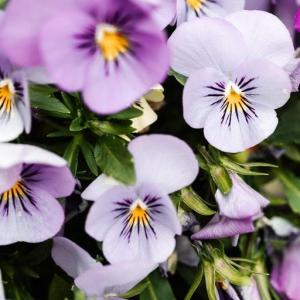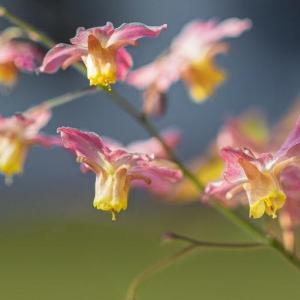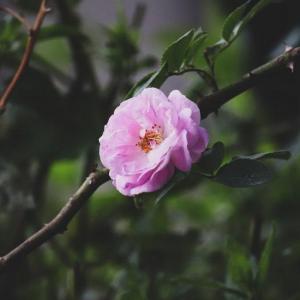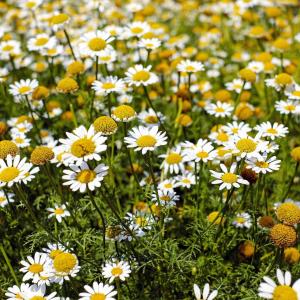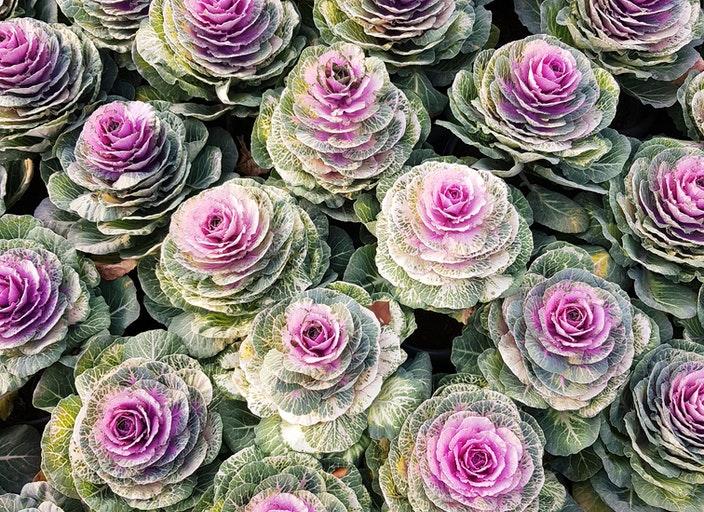
The edible cabbages and kales, the near cousins of ornamental cabbage and kale, are remarkably similar to them in appearance and growth. These beautiful cultivars of the same species (Brassica oleracea) as the eating variety have been developed for aesthetic appeal rather than taste. Despite their little bitterness, they are often used as a garnish. They resemble giant flowers more than vegetables because of the way their leaves create rosettes in hues of purple, rose, and creamy white. In the horticulture industry, blooming cabbages are often referred to as types with smooth leaf edges and large, flat leaves, whereas flowering kales are kinds with serrated or fringed leaf margins. Technically, both are cabbages since genuine cabbage has leaves that form a head, while kale has leaves that form rosettes.
Kale and decorative cabbage are biennials of the chilly season. This implies that they develop their vegetative leaves in the first year and then, the following year, put up blossoms, resulting in the production of seeds before the plant perishes. These quickly expanding plants are, however, often cultivated as annuals for their colorful leaves. They are planted from nursery starts in the autumn or the early spring and then taken out of the garden after the season's display is through.
Care for Decorative Cabbage or Kale
Although they may be vulnerable to some of the same pests that afflict other types of the cabbage family, they are simple plants to cultivate in the majority of sunny regions. If you attempt to grow them in the heat of summer, you may be dissatisfied by how quickly they bolt and go to seed since they favor cool-weather conditions. If they are exposed to chilly, even frigid circumstances, they will produce their most stunning hue.
Light
These plants like growing in full sunlight. However, midday shade is best when cultivated in warmer areas.
These plants thrive in loamy, organically rich soil that drains well. The ideal soil pH range for both cabbage and kale is between 5.5 and 6.5.
Water
Water the plants often; they want continuously damp but not saturated soil. It's time to water if the top inch of soil is dry. You probably won't need to water anything at all if your climate has consistent rainfall. But if there is a dry period, be ready to provide more water. For these plants, 1 inch of water (from irrigation or rainfall) is ideal, but try to avoid overwatering.
Thermodynamics and Humidity
Kale and ornamental cabbage need a good cold from a frost in order to fully develop their hues. They may persist all winter long, although the weather greatly affects how they look. They will flee if it is hot and there is a lot of sunlight (send up a flower stalk and go to seed). Additionally, if it's really rainy and stormy, the plants will deteriorate fast. As long as the temperature is more than 5 degrees Fahrenheit, they can endure. A sudden change in temperature, however, may harm or even kill plants.
These plants normally don't have a problem with humidity. But if the air is stagnant and the weather is moist, plants may get infected with fungus, which often manifests as patches on the leaves. 1
Fertilizer
Use a balanced fertilizer only at planting time to fertilize ornamental kale and cabbage. Avoid fertilizing them while they are still developing to prevent color loss and legginess.
Types of Kale and Cabbage for Decoration
There isn't a lot of diversity available unless you are producing decorative cabbage and kale for a living. The majority of seed packs simply say "ornamental cabbage." Therefore, it is advisable to concentrate on a color scheme that you find appealing. Flowering kale varieties may be categorized as either having "feather-leaved cultivars" or "fringed-leaved cultivars" (those with ruffled leaves) (those with finely serrated leaves).
Several well-liked types include:
"Chidori" decorative kale has leaves that are deep magenta, milky white, or purple and has highly curled leaf margins.
The 'Color Up' decorative cabbage is upright-growing, with green leaves that have white, pink, or fuchsia cores.
The decorative cabbage variety "Osaka" features broad, smooth leaves with pink, red, or white centers. Normally, the plant doesn't grow much.
'Peacock' decorative kale: With loose growth and sharply serrated leaves in shades of red, purple, or white, this plant resembles its food kale relatives more.
The flattened form of the decorative cabbage from the "Pigeon" series features a red or white core.
Growing Ornamental Kale and Cabbage
The second season, when these biennial plants blossom and set seed, is often when they are abandoned. However, if you do let them stay so they may generate seeds, you can harvest the seeds from the fading flower heads and replant them at the right planting time. The seeds may be frozen to keep them fresh for subsequent sowing.
How to Grow Kale and Cabbage From Seeds for Decoration
About eight weeks before to the final anticipated date of frost, cabbage or kale seeds should be planted inside for spring growth. Start the seeds for the autumn show around July 1 and transplant the seedlings into the garden in the middle of August.
Start the seeds inside in little pots with a seed-starting mixture inside. The seeds should be sown in the soil at a depth of approximately 1/4 inch in a light area with a temperature of around 70 degrees Fahrenheit. The potted seedlings may be put outside after the final spring frost, or in mid to late August for fall/winter display. The seedlings will emerge in 10 to 21 days.
Planting and replanting decorative kale and cabbage
Ornamental kale or cabbages sometimes seem more natural when planted in pots as opposed to being dispersed around a garden if you just want one or two plants. Similar to how potted pansies are used in the spring and potted chrysanthemums in the autumn, they may make lovely seasonal potted plants.
Use an all-purpose potting mix and a container with plenty of drainage holes. You usually won't need to bother about repotting nursery plants into a larger container since they probably won't become much bigger than they are when you obtain them.
Overwintering
Kale and ornamental cabbages are often not permitted to overwinter since, when they put up flower stalks in their second year, these biennial plants become fairly unsightly. However, because the leaf rosettes stay lovely until repeatedly strong frosts ultimately force them to wilt, the majority of gardeners will keep them in place far throughout the winter.
Typical Pests and Plant Illnesses
Ornamental cabbages and kale are very vulnerable to cabbage worms, cabbage loopers, flea beetles, caterpillars, thrips, slugs, and aphids, much like many culinary plants in the Brassica genus.
Many of these pests may be removed with hard water sprays. These pests may be controlled using a range of pesticide dusts or horticultural oils made for crops. Kale and cabbage grown in pots may be more resistant to pests and illnesses than those grown in the ground.
Leaf spots, blackleg, black rot, and yellows are examples of common disease issues.
1 When the weather is moist, they are most likely to happen.
Common Issues With Kale and Ornamental Cabbage
Although they are employed as ornamentals, these plants are really vegetables and are thus prone to many common vegetable illnesses and animals that like eating food. You can notice the following significant issues:
Leaves with Holes
The many feeding insects that adore all Brassicaceae family members probably definitely caused this, at least in part. Kale and cabbages are a favorite food of cabbage worms, many other caterpillars, snails, and aphids. Since these plants are often not eaten, you may use more chemicals to manage the pests by using a range of insecticidal soaps or chemical sprays.
Leaves with Black or Yellow Spots
In most cases, spots on leaves rather than holes indicate a bacterial or fungal illness. In wet weather, they are more prone to occur. Keeping proper air circulation might lessen the risk of contracting certain illnesses. If used early enough, fungicides may aid in the treatment of fungal illnesses.
There are ugly tall stalks.
Bolting, or going to bloom, is the abrupt appearance of a sparse and quite unattractive stem on otherwise beautiful cabbage or kale. Its time as an attractive plant is now finished, but if you wish to collect the seeds to start new plants, you may let it grow further.
文章
还没有人评论,快来抢沙发!



